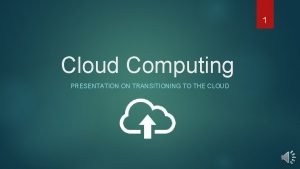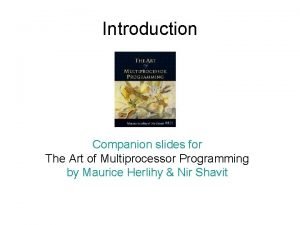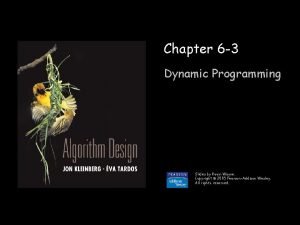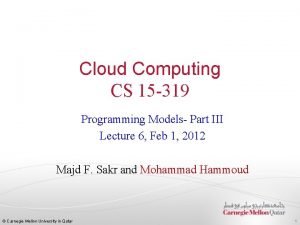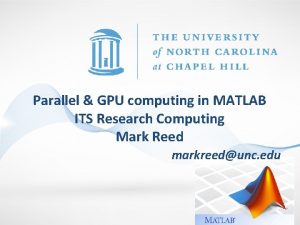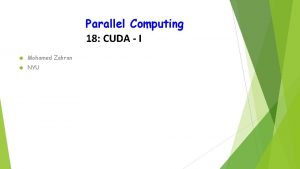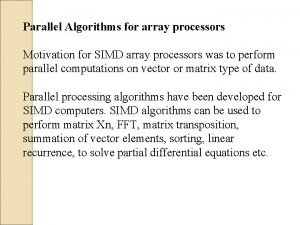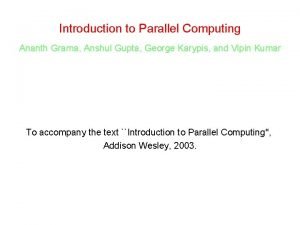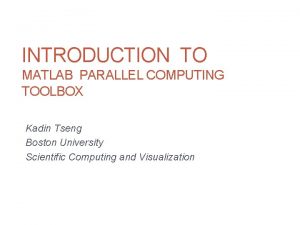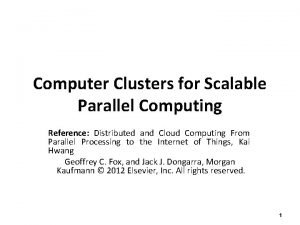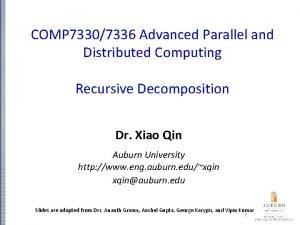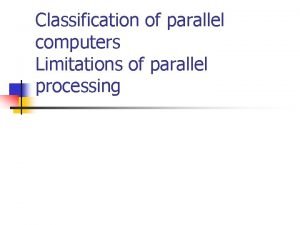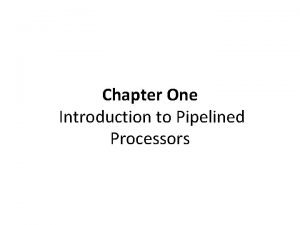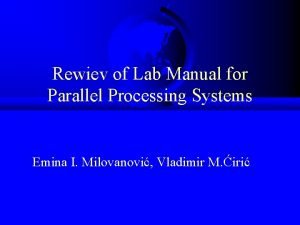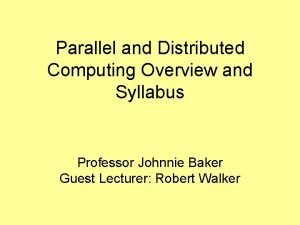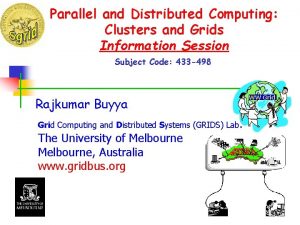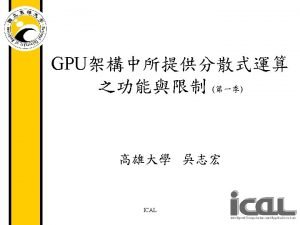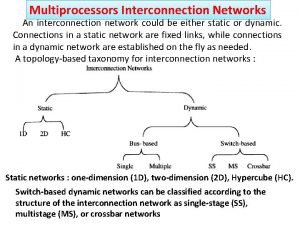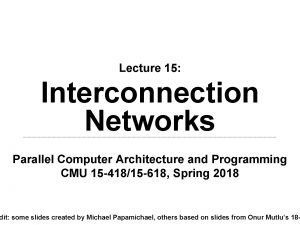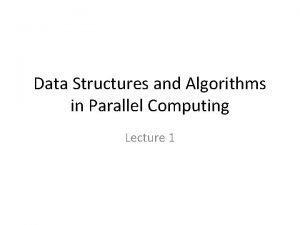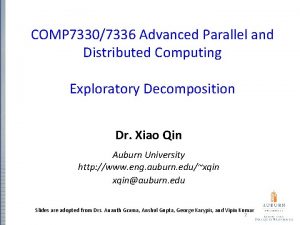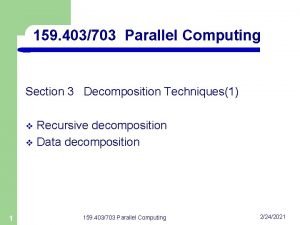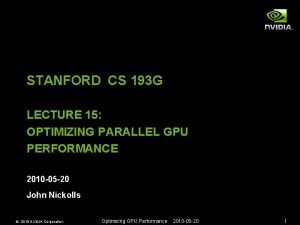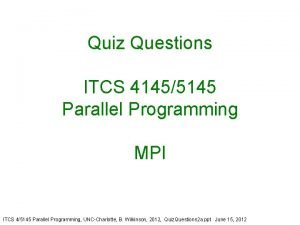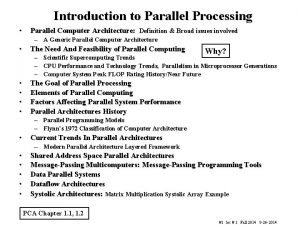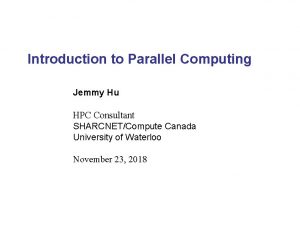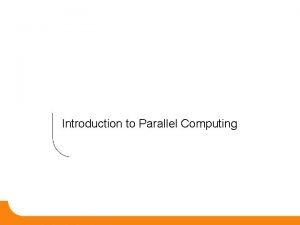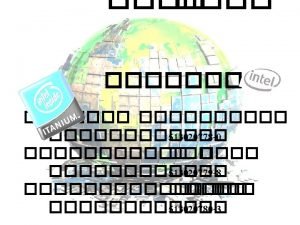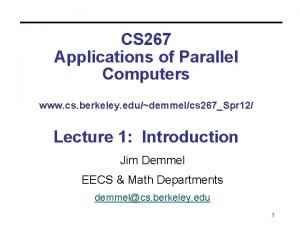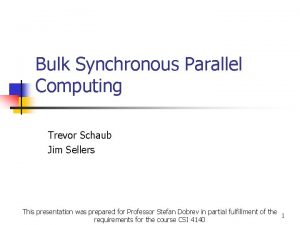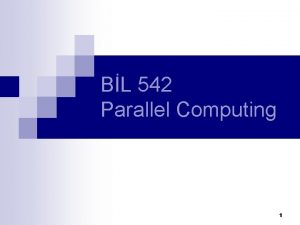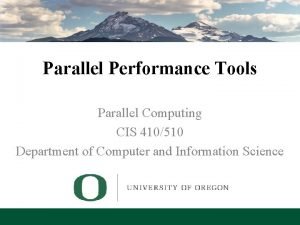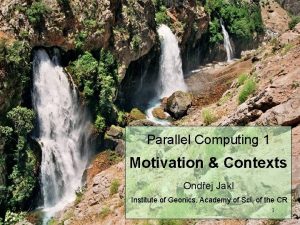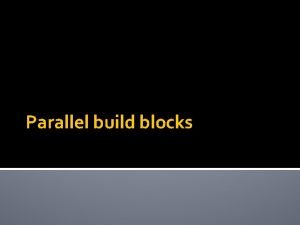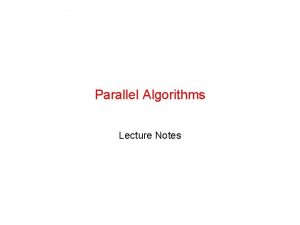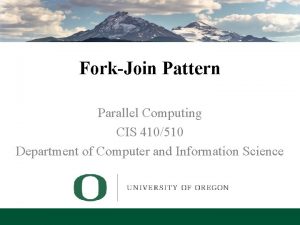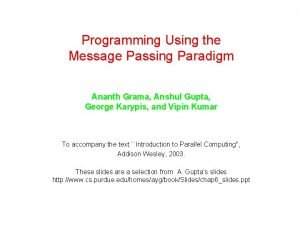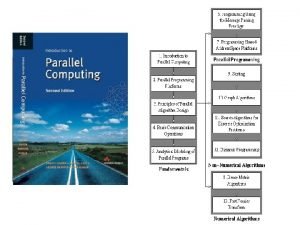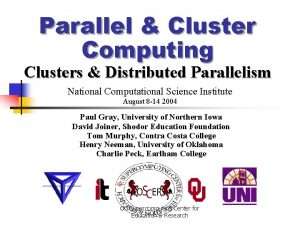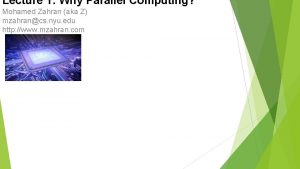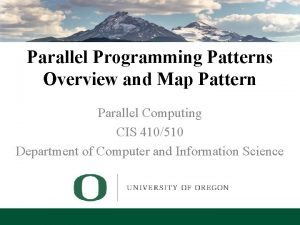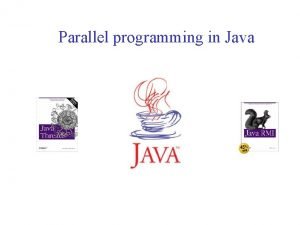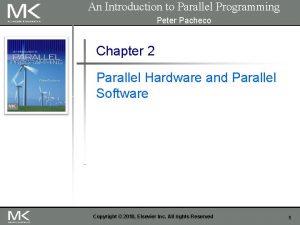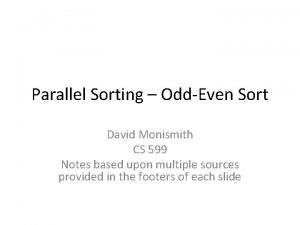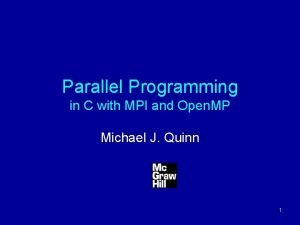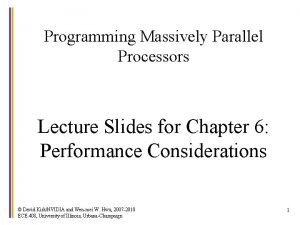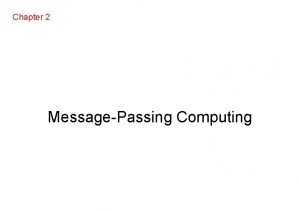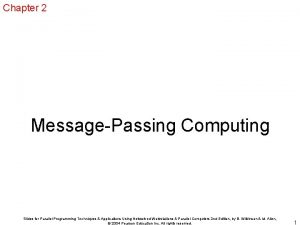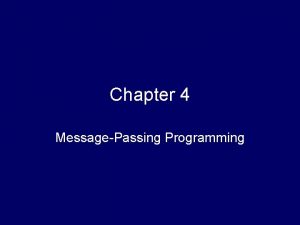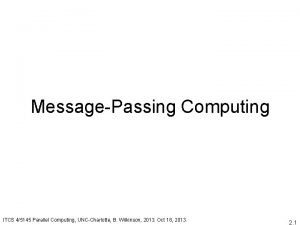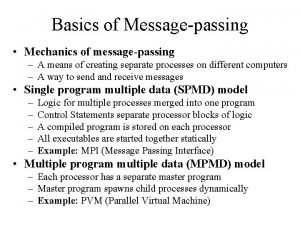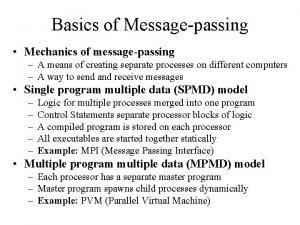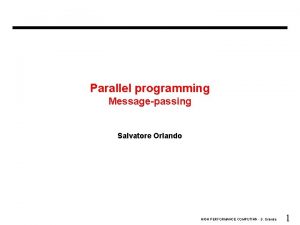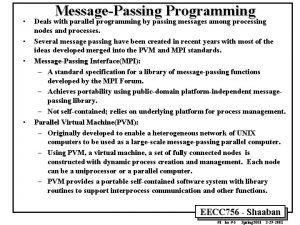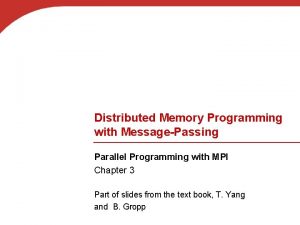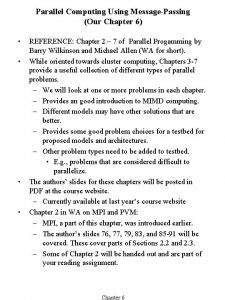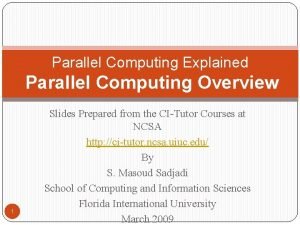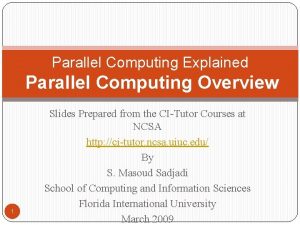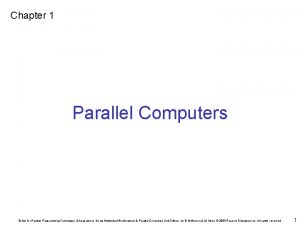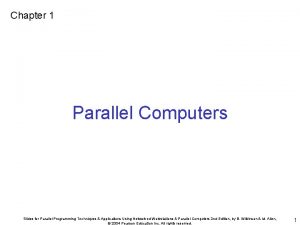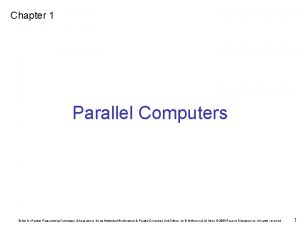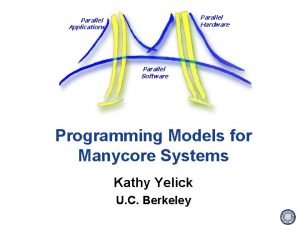Chapter 2 MessagePassing Computing Slides for Parallel Programming
























![Using SPMD Computational Model main (int argc, char *argv[]) { MPI_Init(&argc, &argv); . . Using SPMD Computational Model main (int argc, char *argv[]) { MPI_Init(&argc, &argv); . .](https://slidetodoc.com/presentation_image_h2/1ed42fbdf2f7deddea033a291581927d/image-25.jpg)
































- Slides: 57

Chapter 2 Message-Passing Computing Slides for Parallel Programming Techniques & Applications Using Networked Workstations & Parallel Computers 2 nd Edition, by B. Wilkinson & M. Allen, © 2004 Pearson Education Inc. All rights reserved. 1

Message-Passing Programming using User-level Message Passing Libraries Two primary mechanisms needed: 1. A method of creating separate processes for execution on different computers 2. A method of sending and receiving messages Slides for Parallel Programming Techniques & Applications Using Networked Workstations & Parallel Computers 2 nd Edition, by B. Wilkinson & M. Allen, © 2004 Pearson Education Inc. All rights reserved. 2

Multiple program, multiple data (MPMD) model Slides for Parallel Programming Techniques & Applications Using Networked Workstations & Parallel Computers 2 nd Edition, by B. Wilkinson & M. Allen, © 2004 Pearson Education Inc. All rights reserved. 3

Single Program Multiple Data (SPMD) model. Different processes merged into one program. Control statements select different parts for each processor to execute. All executables started together - static process creation Slides for Parallel Programming Techniques & Applications Using Networked Workstations & Parallel Computers 2 nd Edition, by B. Wilkinson & M. Allen, © 2004 Pearson Education Inc. All rights reserved. 4

Multiple Program Multiple Data (MPMD) Model Separate programs for each processor. One processor executes master process. Other processes started from within master process - dynamic process creation. Slides for Parallel Programming Techniques & Applications Using Networked Workstations & Parallel Computers 2 nd Edition, by B. Wilkinson & M. Allen, © 2004 Pearson Education Inc. All rights reserved. 5

Basic “point-to-point” Send and Receive Routines Passing a message between processes using send() and recv() library calls: Slides for Parallel Programming Techniques & Applications Using Networked Workstations & Parallel Computers 2 nd Edition, by B. Wilkinson & M. Allen, © 2004 Pearson Education Inc. All rights reserved. 6

Synchronous Message Passing Routines that actually return when message transfer completed. Synchronous send routine • Waits until complete message can be accepted by the receiving process before sending the message. Synchronous receive routine • Waits until the message it is expecting arrives. Synchronous routines intrinsically perform two actions: They transfer data and they synchronize processes. Slides for Parallel Programming Techniques & Applications Using Networked Workstations & Parallel Computers 2 nd Edition, by B. Wilkinson & M. Allen, © 2004 Pearson Education Inc. All rights reserved. 7

Synchronous send() and recv() using 3 -way protocol Slides for Parallel Programming Techniques & Applications Using Networked Workstations & Parallel Computers 2 nd Edition, by B. Wilkinson & M. Allen, © 2004 Pearson Education Inc. All rights reserved. 8

Asynchronous Message Passing • Routines that do not wait for actions to complete before returning. Usually require local storage for messages. • More than one version depending upon the actual semantics for returning. • In general, they do not synchronize processes but allow processes to move forward sooner. Must be used with care. Slides for Parallel Programming Techniques & Applications Using Networked Workstations & Parallel Computers 2 nd Edition, by B. Wilkinson & M. Allen, © 2004 Pearson Education Inc. All rights reserved. 9

MPI Definitions of Blocking and Non-Blocking • Blocking - return after their local actions complete, though the message transfer may not have been completed. • Non-blocking - return immediately. Assumes that data storage used for transfer not modified by subsequent statements prior to being used for transfer, and it is left to the programmer to ensure this. These terms may have different interpretations in other systems. Slides for Parallel Programming Techniques & Applications Using Networked Workstations & Parallel Computers 2 nd Edition, by B. Wilkinson & M. Allen, © 2004 Pearson Education Inc. All rights reserved. 10

How message-passing routines return before message transfer completed Message buffer needed between source and destination to hold message: Slides for Parallel Programming Techniques & Applications Using Networked Workstations & Parallel Computers 2 nd Edition, by B. Wilkinson & M. Allen, © 2004 Pearson Education Inc. All rights reserved. 11

Asynchronous (blocking) routines changing to synchronous routines • Once local actions completed and message is safely on its way, sending process can continue with subsequent work. • Buffers only of finite length and a point could be reached when send routine held up because all available buffer space exhausted. • Then, send routine will wait until storage becomes re-available - i. e then routine behaves as a synchronous routine. Slides for Parallel Programming Techniques & Applications Using Networked Workstations & Parallel Computers 2 nd Edition, by B. Wilkinson & M. Allen, © 2004 Pearson Education Inc. All rights reserved. 12

Message Tag • Used to differentiate between different types of messages being sent. • Message tag is carried within message. • If special type matching is not required, a wild card message tag is used, so that the recv() will match with any send(). Slides for Parallel Programming Techniques & Applications Using Networked Workstations & Parallel Computers 2 nd Edition, by B. Wilkinson & M. Allen, © 2004 Pearson Education Inc. All rights reserved. 13

Message Tag Example To send a message, x, with message tag 5 from a source process, 1, to a destination process, 2, and assign to y: Slides for Parallel Programming Techniques & Applications Using Networked Workstations & Parallel Computers 2 nd Edition, by B. Wilkinson & M. Allen, © 2004 Pearson Education Inc. All rights reserved. 14

“Group” message passing routines Have routines that send message(s) to a group of processes or receive message(s) from a group of processes Higher efficiency than separate point-topoint routines although not absolutely necessary. Slides for Parallel Programming Techniques & Applications Using Networked Workstations & Parallel Computers 2 nd Edition, by B. Wilkinson & M. Allen, © 2004 Pearson Education Inc. All rights reserved. 15

Broadcast Sending same message to all processes concerned with problem. Multicast - sending same message to defined group of processes. Slides for Parallel Programming Techniques & Applications Using Networked Workstations & Parallel Computers 2 nd Edition, by B. Wilkinson & M. Allen, © 2004 Pearson Education Inc. All rights reserved. 16

Scatter Sending each element of an array in root process to a separate process. Contents of ith location of array sent to ith process. Slides for Parallel Programming Techniques & Applications Using Networked Workstations & Parallel Computers 2 nd Edition, by B. Wilkinson & M. Allen, © 2004 Pearson Education Inc. All rights reserved. 17

Gather Having one process collect individual values from set of processes. Slides for Parallel Programming Techniques & Applications Using Networked Workstations & Parallel Computers 2 nd Edition, by B. Wilkinson & M. Allen, © 2004 Pearson Education Inc. All rights reserved. 18

Reduce Gather operation combined with specified arithmetic/logical operation. Example: Values could be gathered and then added together by root: Slides for Parallel Programming Techniques & Applications Using Networked Workstations & Parallel Computers 2 nd Edition, by B. Wilkinson & M. Allen, © 2004 Pearson Education Inc. All rights reserved. 19

PVM (Parallel Virtual Machine) Perhaps first widely adopted attempt at using a workstation cluster as a multicomputer platform, developed by Oak Ridge National Laboratories. Available at no charge. Programmer decomposes problem into separate programs (usually master and group of identical slave programs). Programs compiled to execute on specific types of computers. Set of computers used on a problem first must be defined prior to executing the programs (in a hostfile). Slides for Parallel Programming Techniques & Applications Using Networked Workstations & Parallel Computers 2 nd Edition, by B. Wilkinson & M. Allen, © 2004 Pearson Education Inc. All rights reserved. 20

Message routing between computers done by PVM daemon processes installed by PVM on computers that form the virtual machine. Slides for Parallel Programming Techniques & Applications Using Networked Workstations & Parallel Computers 2 nd Edition, by B. Wilkinson & M. Allen, © 2004 Pearson Education Inc. All rights reserved. 21

MPI (Message Passing Interface) • Message passing library standard developed by group of academics and industrial partners to foster more widespread use and portability. • Defines routines, not implementation. • Several free implementations exist. Slides for Parallel Programming Techniques & Applications Using Networked Workstations & Parallel Computers 2 nd Edition, by B. Wilkinson & M. Allen, © 2004 Pearson Education Inc. All rights reserved. 22

MPI Process Creation and Execution • Purposely not defined - Will depend upon implementation. • Only static process creation supported in MPI version 1. All processes must be defined prior to execution and started together. • Originally SPMD model of computation. • MPMD also possible with static creation - each program to be started together specified. Slides for Parallel Programming Techniques & Applications Using Networked Workstations & Parallel Computers 2 nd Edition, by B. Wilkinson & M. Allen, © 2004 Pearson Education Inc. All rights reserved. 23

Communicators • Defines scope of a communication operation. • Processes have ranks associated with communicator. • Initially, all processes enrolled in a “universe” called MPI_COMM_WORLD, and each process is given a unique rank, a number from 0 to p - 1, with p processes. • Other communicators can be established for groups of processes. Slides for Parallel Programming Techniques & Applications Using Networked Workstations & Parallel Computers 2 nd Edition, by B. Wilkinson & M. Allen, © 2004 Pearson Education Inc. All rights reserved. 24
![Using SPMD Computational Model main int argc char argv MPIInitargc argv Using SPMD Computational Model main (int argc, char *argv[]) { MPI_Init(&argc, &argv); . .](https://slidetodoc.com/presentation_image_h2/1ed42fbdf2f7deddea033a291581927d/image-25.jpg)
Using SPMD Computational Model main (int argc, char *argv[]) { MPI_Init(&argc, &argv); . . MPI_Comm_rank(MPI_COMM_WORLD, &myrank); /*find process rank */ if (myrank == 0) master(); else slave(); . . MPI_Finalize(); } where master() and slave() are to be executed by master process and slave process, respectively. Slides for Parallel Programming Techniques & Applications Using Networked Workstations & Parallel Computers 2 nd Edition, by B. Wilkinson & M. Allen, © 2004 Pearson Education Inc. All rights reserved. 25

Unsafe message passing Example Slides for Parallel Programming Techniques & Applications Using Networked Workstations & Parallel Computers 2 nd Edition, by B. Wilkinson & M. Allen, © 2004 Pearson Education Inc. All rights reserved. 26

MPI Solution “Communicators” • Defines a communication domain - a set of processes that are allowed to communicate between themselves. • Communication domains of libraries can be separated from that of a user program. • Used in all point-to-point and collective MPI message-passing communications. Slides for Parallel Programming Techniques & Applications Using Networked Workstations & Parallel Computers 2 nd Edition, by B. Wilkinson & M. Allen, © 2004 Pearson Education Inc. All rights reserved. 27

Default Communicator MPI_COMM_WORLD • Exists as first communicator for all processes existing in the application. • A set of MPI routines exists forming communicators. • Processes have a “rank” in a communicator. Slides for Parallel Programming Techniques & Applications Using Networked Workstations & Parallel Computers 2 nd Edition, by B. Wilkinson & M. Allen, © 2004 Pearson Education Inc. All rights reserved. 28

MPI Point-to-Point Communication • Uses send and receive routines with message tags (and communicator). • Wild card message tags available Slides for Parallel Programming Techniques & Applications Using Networked Workstations & Parallel Computers 2 nd Edition, by B. Wilkinson & M. Allen, © 2004 Pearson Education Inc. All rights reserved. 29

MPI Blocking Routines • Return when “locally complete” - when location used to hold message can be used again or altered without affecting message being sent. • Blocking send will send message and return - does not mean that message has been received, just that process free to move on without adversely affecting message. Slides for Parallel Programming Techniques & Applications Using Networked Workstations & Parallel Computers 2 nd Edition, by B. Wilkinson & M. Allen, © 2004 Pearson Education Inc. All rights reserved. 30

Parameters of blocking send Slides for Parallel Programming Techniques & Applications Using Networked Workstations & Parallel Computers 2 nd Edition, by B. Wilkinson & M. Allen, © 2004 Pearson Education Inc. All rights reserved. 31

Parameters of blocking receive Slides for Parallel Programming Techniques & Applications Using Networked Workstations & Parallel Computers 2 nd Edition, by B. Wilkinson & M. Allen, © 2004 Pearson Education Inc. All rights reserved. 32

Example To send an integer x from process 0 to process 1, MPI_Comm_rank(MPI_COMM_WORLD, &myrank); /* find rank */ if (myrank == 0) { int x; MPI_Send(&x, 1, MPI_INT, 1, msgtag, MPI_COMM_WORLD); } else if (myrank == 1) { int x; MPI_Recv(&x, 1, MPI_INT, 0, msgtag, MPI_COMM_WORLD, status); } Slides for Parallel Programming Techniques & Applications Using Networked Workstations & Parallel Computers 2 nd Edition, by B. Wilkinson & M. Allen, © 2004 Pearson Education Inc. All rights reserved. 33

MPI Nonblocking Routines • Nonblocking send - MPI_Isend() - will return “immediately” even before source location is safe to be altered. • Nonblocking receive - MPI_Irecv() - will return even if no message to accept. Slides for Parallel Programming Techniques & Applications Using Networked Workstations & Parallel Computers 2 nd Edition, by B. Wilkinson & M. Allen, © 2004 Pearson Education Inc. All rights reserved. 34

Nonblocking Routine Formats MPI_Isend(buf, count, datatype, dest, tag, comm, request) MPI_Irecv(buf, count, datatype, source, tag, comm, request) Completion detected by MPI_Wait() and MPI_Test(). MPI_Wait() waits until operation completed and returns then. MPI_Test() returns with flag set indicating whether operation completed at that time. Need to know whether particular operation completed. Determined by accessing request parameter. Slides for Parallel Programming Techniques & Applications Using Networked Workstations & Parallel Computers 2 nd Edition, by B. Wilkinson & M. Allen, © 2004 Pearson Education Inc. All rights reserved. 35

Example To send an integer x from process 0 to process 1 and allow process 0 to continue, MPI_Comm_rank(MPI_COMM_WORLD, &myrank); /* find rank */ if (myrank == 0) { int x; MPI_Isend(&x, 1, MPI_INT, 1, msgtag, MPI_COMM_WORLD, req 1); compute(); MPI_Wait(req 1, status); } else if (myrank == 1) { int x; MPI_Recv(&x, 1, MPI_INT, 0, msgtag, MPI_COMM_WORLD, status); } Slides for Parallel Programming Techniques & Applications Using Networked Workstations & Parallel Computers 2 nd Edition, by B. Wilkinson & M. Allen, © 2004 Pearson Education Inc. All rights reserved. 36

Four Send Communication Modes • Standard Mode Send - Not assumed that corresponding receive routine has started. Amount of buffering not defined by MPI. If buffering provided, send could complete before receive reached. • Buffered Mode - Send may start and return before a matching receive. Necessary to specify buffer space via routine MPI_Buffer_attach(). • Synchronous Mode - Send and receive can start before each other but can only complete together. • Ready Mode - Send can only start if matching receive already reached, otherwise error. Use with care. Slides for Parallel Programming Techniques & Applications Using Networked Workstations & Parallel Computers 2 nd Edition, by B. Wilkinson & M. Allen, © 2004 Pearson Education Inc. All rights reserved. 37

• Each of the four modes can be applied to both blocking and nonblocking send routines. • Only the standard mode is available for the blocking and nonblocking receive routines. • Any type of send routine can be used with any type of receive routine. Slides for Parallel Programming Techniques & Applications Using Networked Workstations & Parallel Computers 2 nd Edition, by B. Wilkinson & M. Allen, © 2004 Pearson Education Inc. All rights reserved. 38

Collective Communication Involves set of processes, defined by an intra-communicator. Message tags not present. Principal collective operations: • • MPI_Bcast() - Broadcast from root to all other processes MPI_Gather() - Gather values for group of processes MPI_Scatter() - Scatters buffer in parts to group of processes MPI_Alltoall() - Sends data from all processes to all processes MPI_Reduce() - Combine values on all processes to single value MPI_Reduce_scatter() - Combine values and scatter results MPI_Scan() - Compute prefix reductions of data on processes Slides for Parallel Programming Techniques & Applications Using Networked Workstations & Parallel Computers 2 nd Edition, by B. Wilkinson & M. Allen, © 2004 Pearson Education Inc. All rights reserved. 39

Example To gather items from group of processes into process 0, using dynamically allocated memory in root process: int data[10]; /*data to be gathered from processes*/ MPI_Comm_rank(MPI_COMM_WORLD, &myrank); /* find rank */ if (myrank == 0) { MPI_Comm_size(MPI_COMM_WORLD, &grp_size); /*find group size*/ buf = (int *)malloc(grp_size*10*sizeof (int)); /*allocate memory*/ } MPI_Gather(data, 10, MPI_INT, buf, grp_size*10, MPI_INT, 0, MPI_COMM_WORLD) ; MPI_Gather() gathers from all processes, including root. Slides for Parallel Programming Techniques & Applications Using Networked Workstations & Parallel Computers 2 nd Edition, by B. Wilkinson & M. Allen, © 2004 Pearson Education Inc. All rights reserved. 40

Barrier • As in all message-passing systems, MPI provides a means of synchronizing processes by stopping each one until they all have reached a specific “barrier” call. Slides for Parallel Programming Techniques & Applications Using Networked Workstations & Parallel Computers 2 nd Edition, by B. Wilkinson & M. Allen, © 2004 Pearson Education Inc. All rights reserved. 41

#include “mpi. h” #include <stdio. h> #include <math. h> #define MAXSIZE 1000 void main(int argc, char *argv) { int myid, numprocs; int data[MAXSIZE], i, x, low, high, myresult, result; char fn[255]; char *fp; MPI_Init(&argc, &argv); MPI_Comm_size(MPI_COMM_WORLD, &numprocs); MPI_Comm_rank(MPI_COMM_WORLD, &myid); if (myid == 0) { /* Open input file and initialize data */ strcpy(fn, getenv(“HOME”)); strcat(fn, ”/MPI/rand_data. txt”); if ((fp = fopen(fn, ”r”)) == NULL) { printf(“Can’t open the input file: %snn”, fn); exit(1); } for(i = 0; i < MAXSIZE; i++) fscanf(fp, ”%d”, &data[i]); } MPI_Bcast(data, MAXSIZE, MPI_INT, 0, MPI_COMM_WORLD); /* broadcast data */ x = n/nproc; /* Add my portion Of data */ low = myid * x; high = low + x; for(i = low; i < high; i++) myresult += data[i]; printf(“I got %d from %dn”, myresult, myid); /* Compute global sum */ MPI_Reduce(&myresult, &result, 1, MPI_INT, MPI_SUM, 0, MPI_COMM_WORLD); if (myid == 0) printf(“The sum is %d. n”, result); MPI_Finalize(); } Sample MPI program Slides for Parallel Programming Techniques & Applications Using Networked Workstations & Parallel Computers 2 nd Edition, by B. Wilkinson & M. Allen, © 2004 Pearson Education Inc. All rights reserved. 42

Evaluating Parallel Programs Slides for Parallel Programming Techniques & Applications Using Networked Workstations & Parallel Computers 2 nd Edition, by B. Wilkinson & M. Allen, © 2004 Pearson Education Inc. All rights reserved. 43

Sequential execution time, ts: Estimate by counting computational steps of best sequential algorithm. Parallel execution time, tp: In addition to number of computational steps, tcomp, need to estimate communication overhead, tcomm: tp = tcomp + tcomm Slides for Parallel Programming Techniques & Applications Using Networked Workstations & Parallel Computers 2 nd Edition, by B. Wilkinson & M. Allen, © 2004 Pearson Education Inc. All rights reserved. 44

Computational Time Count number of computational steps. When more than one process executed simultaneously, count computational steps of most complex process. Generally, function of n and p, i. e. tcomp = f (n, p) Often break down computation time into parts. Then tcomp = tcomp 1 + tcomp 2 + tcomp 3 + … Analysis usually done assuming that all processors are same and operating at same speed. Slides for Parallel Programming Techniques & Applications Using Networked Workstations & Parallel Computers 2 nd Edition, by B. Wilkinson & M. Allen, © 2004 Pearson Education Inc. All rights reserved. 45

Communication Time Many factors, including network structure and network contention. As a first approximation, use tcomm = tstartup + ntdata tstartup is startup time, essentially time to send a message with no data. Assumed to be constant. tdata is transmission time to send one data word, also assumed constant, and there are n data words. Slides for Parallel Programming Techniques & Applications Using Networked Workstations & Parallel Computers 2 nd Edition, by B. Wilkinson & M. Allen, © 2004 Pearson Education Inc. All rights reserved. 46

Idealized Communication Time Slides for Parallel Programming Techniques & Applications Using Networked Workstations & Parallel Computers 2 nd Edition, by B. Wilkinson & M. Allen, © 2004 Pearson Education Inc. All rights reserved. 47

Final communication time, tcomm, the summation of communication times of all sequential messages from a process, i. e. tcomm = tcomm 1 + tcomm 2 + tcomm 3 + … Typically, communication patterns of all processes same and assumed to take place together so that only one process need be considered. Both startup and data transmission times, tstartup and tdata, measured in units of one computational step, so that can add tcomp and tcomm together to obtain parallel execution time, tp. Slides for Parallel Programming Techniques & Applications Using Networked Workstations & Parallel Computers 2 nd Edition, by B. Wilkinson & M. Allen, © 2004 Pearson Education Inc. All rights reserved. 48

Benchmark Factors With ts, tcomp, and tcomm, can establish speedup factor and computation/communication ratio for a particular algorithm/implementation: Both functions of number of processors, p, and number of data elements, n. Will give indication of scalability of parallel solution with increasing number of processors and problem size. Computation/communication ratio will highlight effect of communication with increasing problem size and system size. Slides for Parallel Programming Techniques & Applications Using Networked Workstations & Parallel Computers 2 nd Edition, by B. Wilkinson & M. Allen, © 2004 Pearson Education Inc. All rights reserved. 49

Debugging and Evaluating Parallel Programs Empirically Visualization Tools Programs can be watched as they are executed in a space-time diagram (or process-time diagram): Slides for Parallel Programming Techniques & Applications Using Networked Workstations & Parallel Computers 2 nd Edition, by B. Wilkinson & M. Allen, © 2004 Pearson Education Inc. All rights reserved. 50

Implementations of visualization tools are available for MPI. An example is the Upshot program visualization system. Slides for Parallel Programming Techniques & Applications Using Networked Workstations & Parallel Computers 2 nd Edition, by B. Wilkinson & M. Allen, © 2004 Pearson Education Inc. All rights reserved. 51

Evaluating Programs Empirically Measuring Execution Time To measure the execution time between point L 1 and point L 2 in the code, we might have a construction such as. L 1: time(&t 1); /* start timer */. . L 2: time(&t 2); /* stop timer */. elapsed_time = difftime(t 2, t 1); /* elapsed_time = t 2 - t 1 */ printf(“Elapsed time = %5. 2 f seconds”, elapsed_time); MPI provides the routine MPI_Wtime() for returning time (in seconds). Slides for Parallel Programming Techniques & Applications Using Networked Workstations & Parallel Computers 2 nd Edition, by B. Wilkinson & M. Allen, © 2004 Pearson Education Inc. All rights reserved. 52

Parallel Programming Home Page http: //www. cs. uncc. edu/par_prog Gives step-by-step instructions for compiling and executing programs, and other information. Slides for Parallel Programming Techniques & Applications Using Networked Workstations & Parallel Computers 2 nd Edition, by B. Wilkinson & M. Allen, © 2004 Pearson Education Inc. All rights reserved. 53

Compiling/Executing MPI Programs Preliminaries • Set up paths • Create required directory structure • Create a file (hostfile) listing machines to be used (required) Details described on home page. Slides for Parallel Programming Techniques & Applications Using Networked Workstations & Parallel Computers 2 nd Edition, by B. Wilkinson & M. Allen, © 2004 Pearson Education Inc. All rights reserved. 54

Hostfile Before starting MPI for the first time, need to create a hostfile Sample hostfile ws 404 #is-sm 1 //Currently not executing, commented pvm 1 //Active processors, UNCC sun cluster called pvm 1 - pvm 8 pvm 2 pvm 3 pvm 4 pvm 5 pvm 6 pvm 7 pvm 8 Slides for Parallel Programming Techniques & Applications Using Networked Workstations & Parallel Computers 2 nd Edition, by B. Wilkinson & M. Allen, © 2004 Pearson Education Inc. All rights reserved. 55

Compiling/executing (SPMD) MPI program For LAM MPI version 6. 5. 2. At a command line: To start MPI: First time: Subsequently: lamboot -v hostfile lamboot To compile MPI programs: mpicc -o file. c or mpi. CC -o file. cpp To execute MPI program: mpirun -v -np no_processors file To remove processes for reboot lamclean -v Terminate LAM lamhalt If fails wipe -v lamhost Slides for Parallel Programming Techniques & Applications Using Networked Workstations & Parallel Computers 2 nd Edition, by B. Wilkinson & M. Allen, © 2004 Pearson Education Inc. All rights reserved. 56

Compiling/Executing Multiple MPI Programs Create a file specifying programs: Example 1 master and 2 slaves, “appfile” contains n 0 master n 0 -1 slave To execute: mpirun -v appfile Sample output 3292 master running on n 0 (o) 3296 slave running on n 0 (o) 412 slave running on n 1 Slides for Parallel Programming Techniques & Applications Using Networked Workstations & Parallel Computers 2 nd Edition, by B. Wilkinson & M. Allen, © 2004 Pearson Education Inc. All rights reserved. 57
 A small child slides down the four frictionless slides
A small child slides down the four frictionless slides A crane lowers a girder into place
A crane lowers a girder into place Conclusion for cloud computing presentation
Conclusion for cloud computing presentation Multiprocessor
Multiprocessor Dynamic programming slides
Dynamic programming slides Conventional computing and intelligent computing
Conventional computing and intelligent computing Cloud computing programming models
Cloud computing programming models Cloud computing programming models
Cloud computing programming models Perbedaan linear programming dan integer programming
Perbedaan linear programming dan integer programming Greedy algorithm vs dynamic programming
Greedy algorithm vs dynamic programming Definition of system programming
Definition of system programming Integer programming vs linear programming
Integer programming vs linear programming Definisi linear
Definisi linear Matlab spmd vs parfor
Matlab spmd vs parfor Nyu parallel computing
Nyu parallel computing Associative array processing in parallel computing
Associative array processing in parallel computing Motivating parallelism
Motivating parallelism Drange matlab
Drange matlab Design objectives of computer clusters
Design objectives of computer clusters Recursive decomposition example
Recursive decomposition example Cloud computing lecture
Cloud computing lecture Classify the limitations of parallel computing
Classify the limitations of parallel computing Handler's classification in parallel computing
Handler's classification in parallel computing Parallel computing lab manual
Parallel computing lab manual Parallel and distributed computing course outline
Parallel and distributed computing course outline Cluster in parallel and distributed computing
Cluster in parallel and distributed computing Conclusion of parallel computing
Conclusion of parallel computing Lara srivastava
Lara srivastava Cmu parallel computing
Cmu parallel computing Data structures for parallel computing
Data structures for parallel computing Exploratory decomposition in parallel computing
Exploratory decomposition in parallel computing All-to-all personalized communication
All-to-all personalized communication Recursive decomposition in parallel computing
Recursive decomposition in parallel computing Cs193 stanford
Cs193 stanford Mpi quiz
Mpi quiz Parallel computing definition
Parallel computing definition Parallel computing
Parallel computing Parallel computing
Parallel computing Explicitly parallel instruction computing
Explicitly parallel instruction computing Cs267 berkeley
Cs267 berkeley Superstepn
Superstepn Parallel computing
Parallel computing In parallel computing
In parallel computing Parallel computing
Parallel computing In parallel computing
In parallel computing Parallel distributed computing
Parallel distributed computing In parallel computing
In parallel computing Introduction to parallel computing ananth grama ppt
Introduction to parallel computing ananth grama ppt Introduction to parallel computing ananth grama
Introduction to parallel computing ananth grama Distributed, parallel, and cluster computing
Distributed, parallel, and cluster computing Parallel computing nyu
Parallel computing nyu Programming massively parallel processors
Programming massively parallel processors Scala parallel map
Scala parallel map Java parallel programming
Java parallel programming An introduction to parallel programming peter pacheco
An introduction to parallel programming peter pacheco Bubble sort parallel programming
Bubble sort parallel programming Mpi parallel programming in c
Mpi parallel programming in c Programming massively parallel processors
Programming massively parallel processors


